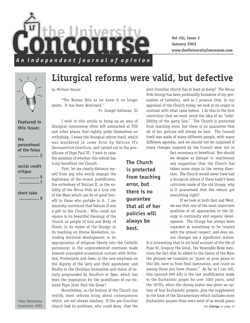Social Credit is no alternative
by Joseph Zoric
In his article, “Social credit: a distributist reform of the financial system,” (Volume 8, issue 1) Oliver Heydorn draws out the discussion of distributism with a radical critique of financial markets in modern, mixed economies (which he calls capitalist.) He then goes on to propose “social credit” as an alternative. Both the critique and the proposal display a serious lack of basic economic knowledge.
Following the lead of other proponents of distributism in the Concourse, Heydorn distinguishes that system from socialism by explaining that “the bodies that would be largely responsible for ensuring this more adequate distribution [of productive property] would be non-governmental occupational groups or guilds.” We reply that such “non-governmental” groups or guilds would require precisely the same kind of coercive powers required by a government body to achieve the desired redistribution. Further, what is implied by this idealistic mechanism for ensuring a “more adequate” distribution is a value judgment that the present state of affairs is not desirable. We reply that if the present distribution really is not desirable (and, presumably, this has been the case through the history of capitalist social organization), then the distributist world ought to have spontaneously arisen through the free actions of persons. Finally, every scheme of property limitation or expansion, either via explicit or implicit taxes and subsidies (or regulations, or social conventions, or whatever these guilds will use), would involve usurpation of individual volition.
In essence, occupational groups and guilds given powers to restructure economic organization would be governmental bodies, whatever they are called. The problems inherent to public choice would arise as in any explicitly named governmental body. The essential reason for this is that the distributist plan replaces private enterprise with an indirect provider (the guilds.) There would be no personal decision concerning property, but instead there would be a third-party decision. By their nature, the guilds would be governmental given their effects. The net result would be confiscation of private property by one group (the guilds) and redistribution to another group with the most influence over the guilds.
Heydorn next tells us a loan may be non-productive in two ways, either it finances non-productive activity or it is not the product of a cost-generating process. From this non-productive financing, the interest on the loan, he claims, is usury. We question the premise that any loan would be non-productive in the ways mentioned. What financier, if he is sane, writes a promissory note for non-productive activity? True, he may make a mistake, but he will be once bitten and twice shy. Try it out. See if any banker will give you a loan for something that will be non-productive. Tell the loan officer you will gamble in Vegas with the funds. Or, tell him you want to stash all the money in a mattress somewhere. You will be laughed out of the bank.
A loan is always the product of a cost-generating activity. Banks, investment houses, brokers and all financial intermediaries use resources that have alternative uses. Resources are scarce and therefore costly. Loanable funds are scarce and costly, just as are all goods on the shelf at your local Wal-Mart. The loanable funds arise from individuals and institutions that save. Their saving requires them to forgo present consumption, a cost to the savers. Those who save are compensated for this by being paid interest—a payment for funds that includes the cost of capital services that could be generated by the funds by the individual. In essence, interest is a price signal used to coordinate the actions of savers and borrowers, relying on individual preferences for settling risks of waiting for future repayments.
The financial system serves as an intermediary, connecting the savers to the borrowers. The interest paid to savers is thus a cost inherent to the loan process. In addition, a financier has alternative projects he could finance. Writing a loan for one project implies the returns from alternative projects are forgone. In reality, neither condition of non-productivity exists, so interest on loans is not usury. It should be noted that usury remains condemned in the Catholic tradition, but as the moral theologian Germain Grisez points out: “The Church never taught that all charging of interest is wrong, but only that it is wrong to charge interest on a loan in virtue of the very making of the loan, rather than in virtue of some factor related to the loan which provides a basis for fair compensation.”1 For example, a loan shark who imposes triple-digit interest on debtors commits the sin of usury.
Again, we quote Heydorn: “Whenever a banker creates a loan and demands to be paid back with interest, he only introduces the principal into the monetary supply; he does not introduce any money to cover the interest payments which may, in the long run, amount to more than the principal itself.” We reply that a banker does not pay the interest; he receives the interest. The interest is an expense payable by the borrower from the cash flow associated with the productive activity financed by the loan.
Heydorn then leaps to his greatest myth: “The result is that under the current financial set-up there is a chronic lack of money that artificially limits both production and consumption.” Let us reply. Production does not come from money but from real resources such as human effort and knowledge and technological know-how. Money itself produces nothing. Thus, the quantity of money has nothing to do with the level of production and consumption. We reply further that the limited money supply is necessary, because money is not a productive resource; it is merely a means of reducing transaction costs expended by a society to allocate real resources to their best uses. The “chronic lack of money” is actually a good thing. Why? because the long-run effect of “more” money is higher prices. Ask anyone who has lived in half the nations of the world in the past thirty years: “What happens when the government increases the money supply?” Anyone who did not have his head in the sand will tell you: “We had inflation.”
Mr. Heydorn’s policy proposal would produce a hyperinflation that would destroy our economic system.
According to Heydorn, the fractional reserve system of banking “leads to escalating personal, corporate, and government debts, wasteful economic growth, environmental degradation” We reply:
(a) The notion of “escalating debt” needs a reference point. Heydorn fails to put the facts into perspective. For example, the present U.S. national debt is approximately 60% of GDP. This is significantly lower than the debt to GDP ratio experienced, say, during World War II (when national debt ran about 200% of GDP.) Thus, government debt is hardly “escalating.” As for personal debt, the main culprit is mortgage debt, a financing instrument that enables millions of people to enjoy housing services while building an equity nest egg. Corporate debt is not escalating either. Even if it were, then more and more Americans would be providing the corporations with their saved funds, and this would happen only if the reward for saving were high enough to induce forgoing current consumption. Interest rates are at their lowest in forty years. No, we say to the hen, the sky is not falling.
(b) “Wasteful economic growth”?! What does Heydorn mean by this? How is economic growth wasteful? We hold that economic growth arises from increases in worker productivity, which arises from financing human and physical capital formulation. Economic growth over the last century has helped American society pay for enhanced health care, technology, and rising life expectancy. Economic growth leads to enhanced standards of living; it means people become better off materially (such that a 21st Century American adult has seven times the purchasing power of someone living in the year 1931.)
(c) “Environmental degradation” arises from inadequate definition and protection of property rights. It has nothing to do with fractional reserve banking, as Heydorn claims. (And, by the way, by all indications the environment in the U.S. is improving dramatically and is expected to continue to do so). Further, moving to a 100% reserve system would cut the money supply and remove any dynamics that could potentially enable entrepreneurs to finance projects that actually clean the environment.
In essence, Heydorn’s critique of financial intermediation contains numerous errors. His alternative proposal of a system of “social credit” is no better.
Heydorn proposes that fractional reserve banking “be replaced by full reserve banking, so that the banks could no longer produce most of a country’s money supply for personal gain.” In effect, the banks would no longer be financial intermediaries specializing in matching savers with borrowers. Their greatest contribution to the economy, decreasing the costs associated with matching borrowers with savers, would no longer exist. The result would be total collapse of an otherwise (and presently) stable financial system, a permanent decrease in economic activity, a long term contraction of output, massive layoffs of workers, panic spreading to all other intermediaries, and massive misallocation of productive property—all the exact reverse of the distributist ideal. In other words, we could say that to implement such a system would be immoral exactly on distributist grounds.
What we have in Heydorn’s article is a collection of the worst myths and legends of the last fifty years concerning money and banking, with which readers of crank anti-capitalist web pages are very familiar. Fortunately, there are other websites to be found (see for instance, http://www.floodlight.org/theory/contents.html, or http://www.home.earthlink.net/~flahertyhsd), which do a more complete and eloquent job of debunking such myths than we’ve been able to attempt here. Here we’ve can only scratch the surface, and express our hope that future contributors to the Concourse on these topics will be more informed about economics. n
Professors Welker and Zoric teach Economics at FUS.
- German Grisez, The Way of the Lord Jesus: vol. II Living a Christian Life (Quincy, Illinois:Franciscan Press, 1993) 834. ↑


